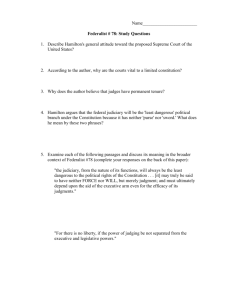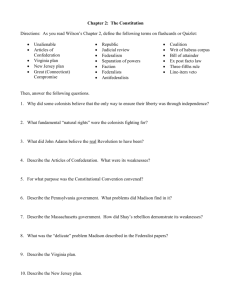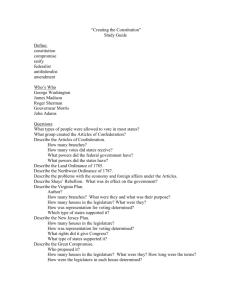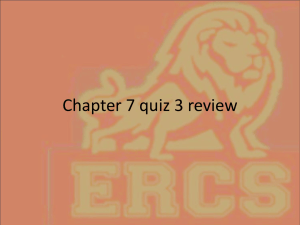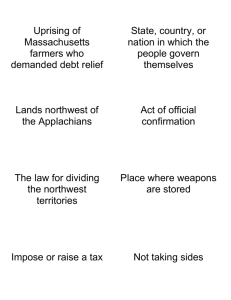File
advertisement
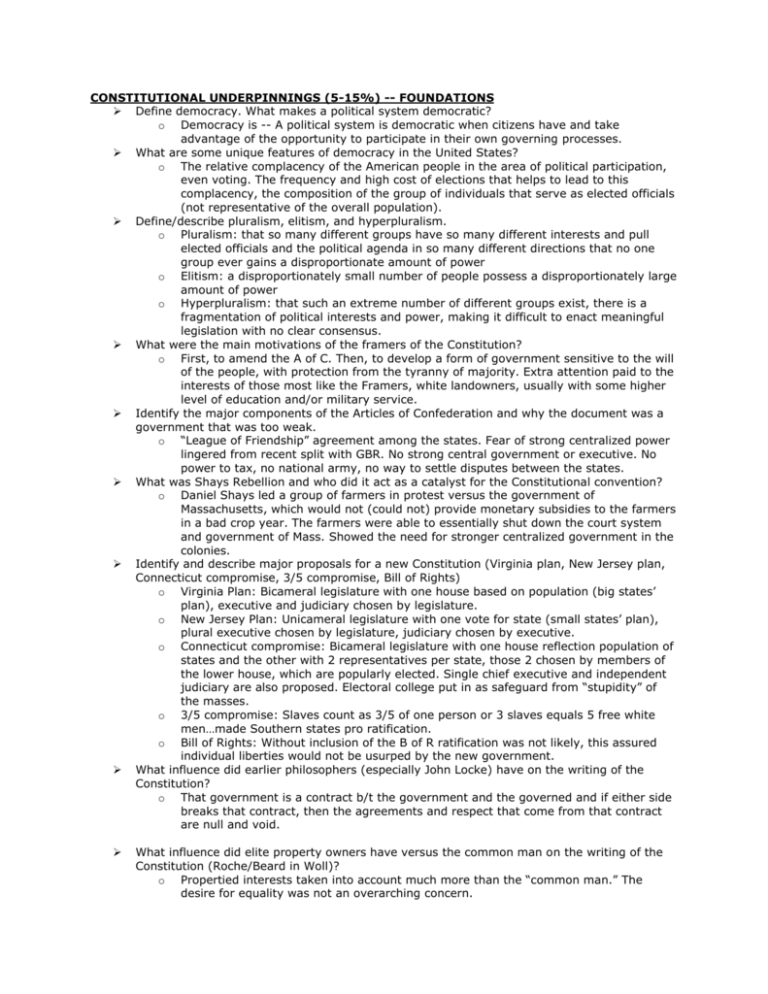
CONSTITUTIONAL UNDERPINNINGS (5-15%) -- FOUNDATIONS Define democracy. What makes a political system democratic? o Democracy is -- A political system is democratic when citizens have and take advantage of the opportunity to participate in their own governing processes. What are some unique features of democracy in the United States? o The relative complacency of the American people in the area of political participation, even voting. The frequency and high cost of elections that helps to lead to this complacency, the composition of the group of individuals that serve as elected officials (not representative of the overall population). Define/describe pluralism, elitism, and hyperpluralism. o Pluralism: that so many different groups have so many different interests and pull elected officials and the political agenda in so many different directions that no one group ever gains a disproportionate amount of power o Elitism: a disproportionately small number of people possess a disproportionately large amount of power o Hyperpluralism: that such an extreme number of different groups exist, there is a fragmentation of political interests and power, making it difficult to enact meaningful legislation with no clear consensus. What were the main motivations of the framers of the Constitution? o First, to amend the A of C. Then, to develop a form of government sensitive to the will of the people, with protection from the tyranny of majority. Extra attention paid to the interests of those most like the Framers, white landowners, usually with some higher level of education and/or military service. Identify the major components of the Articles of Confederation and why the document was a government that was too weak. o “League of Friendship” agreement among the states. Fear of strong centralized power lingered from recent split with GBR. No strong central government or executive. No power to tax, no national army, no way to settle disputes between the states. What was Shays Rebellion and who did it act as a catalyst for the Constitutional convention? o Daniel Shays led a group of farmers in protest versus the government of Massachusetts, which would not (could not) provide monetary subsidies to the farmers in a bad crop year. The farmers were able to essentially shut down the court system and government of Mass. Showed the need for stronger centralized government in the colonies. Identify and describe major proposals for a new Constitution (Virginia plan, New Jersey plan, Connecticut compromise, 3/5 compromise, Bill of Rights) o Virginia Plan: Bicameral legislature with one house based on population (big states’ plan), executive and judiciary chosen by legislature. o New Jersey Plan: Unicameral legislature with one vote for state (small states’ plan), plural executive chosen by legislature, judiciary chosen by executive. o Connecticut compromise: Bicameral legislature with one house reflection population of states and the other with 2 representatives per state, those 2 chosen by members of the lower house, which are popularly elected. Single chief executive and independent judiciary are also proposed. Electoral college put in as safeguard from “stupidity” of the masses. o 3/5 compromise: Slaves count as 3/5 of one person or 3 slaves equals 5 free white men…made Southern states pro ratification. o Bill of Rights: Without inclusion of the B of R ratification was not likely, this assured individual liberties would not be usurped by the new government. What influence did earlier philosophers (especially John Locke) have on the writing of the Constitution? o That government is a contract b/t the government and the governed and if either side breaks that contract, then the agreements and respect that come from that contract are null and void. What influence did elite property owners have versus the common man on the writing of the Constitution (Roche/Beard in Woll)? o Propertied interests taken into account much more than the “common man.” The desire for equality was not an overarching concern. Explain the fears the framers had in a pure democracy and how they set up safeguards against popular rule framers mistrusted popular passions, direct participation by the people. Representative democracy created a republic. Senators selected by state legislatures, president by electoral college. Amendment process: slow and difficult (2/3 Congress & ¾ of states). Separation of Powers= slow gov’t, less responsive to popular shifts How did the Federalist encourage the people of the states to ratify the Constitution? Summarize the main ideas in Federalist # 10 & #51 Federalist Papers that explained various features of the Constitution. Federalist # 10: How to deal with factions (interest groups/parties). Factions are bad (selfish), may conflict with public good, oppress minorities. Cause of faction: liberty and economic inequalities. Solution: control the effects of faction rather than try to eliminate their causes. How? Create a large republic with many interest so no one group will dominate (Pluralism) minority rights are more secure. Federalist # 51: Checks and balances are necessary to protect liberty. Human nature often negative, selfish and ambitious. Create a system of separate institutions sharing power. federalism enables one level of gov’t to check the other. Describe why the Anti=Federalist opposed the Constitution Anti-Federalist support state’s rights. A strong central government may endanger liberty, let elites dominate. NEED a Bill of Rights to protect liberty How can the Constitution be amended? Why is it so difficult to amend the Constitution? How else can the Constitution be changed? o 2/3 vote of proposal by both houses or by 2/3 of state legislatures, ¾ vote of ratification by both houses or by ¾ of the state legislatures. Also is potentially amended by orders of the President. Describe how and why the Bill of Rights was added to the Constitution. o Without inclusion of the B of R ratification was not likely, this assured individual liberties would not be usurped by the new government. What are the components of Articles I, II, and III? o Article I: Legislative powers; Article II: Executive powers; Article III: Judicial powers; each loosely delineates the structure and function of each branch What is the differenced b/t an implied and an expressed power? o Expressed: clearly stated (written) in the Constitution o Implied: implied by the expressed powers written in the Constitution Describe the structure and function of the Electoral College. o # of electors = # of Representatives + # of Senators for each state. With the exception of Maine and Nebraska, electoral votes are awarded on a “winner take all” basis, that is, the winner of the plurality of votes in a given state receives all of the electoral votes of that state. 270 votes needed to assure presidency. Identify and describe the importance of Marbury v. Madison. o Established Constitutionality of judicial review, that is, the judiciary has the power to review acts of the legislature and decide whether or not they are permissible.
